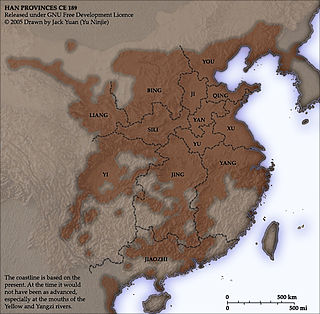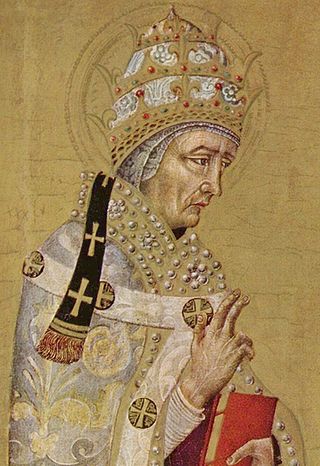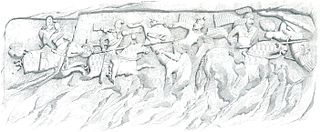The 150s decade ran from January 1, 150, to December 31, 159.
Year 245 (CCXLV) was a common year starting on Wednesday of the Julian calendar. At the time, it was known as the Year of the Consulship of Philippus and Titianus. The denomination 245 for this year has been used since the early medieval period, when the Anno Domini calendar era became the prevalent method in Europe for naming years.

Year 329 (CCCXXIX) was a common year starting on Wednesday of the Julian calendar. At the time, it was known as the Year of the Consulship of Constantinus and Constantinus. The denomination 329 for this year has been used since the early medieval period, when the Anno Domini calendar era became the prevalent method in Europe for naming years.

Year 189 (CLXXXIX) was a common year starting on Wednesday of the Julian calendar. At the time, it was known as the Year of the Consulship of Silanus and Silanus. The denomination 189 for this year has been used since the early medieval period, when the Anno Domini calendar era became the prevalent method in Europe for naming years.

Year 236 (CCXXXVI) was a leap year starting on Friday of the Julian calendar. At the time, it was known as the Year of the Consulship of Verus and Africanus. The denomination 236 for this year has been used since the early medieval period, when the Anno Domini calendar era became the prevalent method in Europe for naming years.
The 230s decade ran from January 1, 230, to December 31, 239.
Year 255 (CCLV) was a common year starting on Monday of the Julian calendar. At the time, it was known in Rome as the Year of the Consulship of Valerianus and Gallienus. The denomination 255 for this year has been used since the early medieval period, when the Anno Domini calendar era became the prevalent method in Europe for naming years.

Year 234 (CCXXXIV) was a common year starting on Wednesday of the Julian calendar. At the time, it was known as the Year of the Consulship of Pupienus and Sulla. The denomination 234 for this year has been used since the early medieval period, when the Anno Domini calendar era became the prevalent method in Europe for naming years.
Year 264 (CCLXIV) was a leap year starting on Friday of the Julian calendar. At the time, it was known as the Year of the Consulship of Gallienus and Saturninus. The denomination 264 for this year has been used since the early medieval period, when the Anno Domini calendar era became the prevalent method in Europe for naming years.
Year 184 (CLXXXIV) was a leap year starting on Wednesday of the Julian calendar. At the time, it was known as the Year of the Consulship of Eggius and Aelianus. The denomination 184 for this year has been used since the early medieval period, when the Anno Domini calendar era became the prevalent method in Europe for naming years.
Year 205 (CCV) was a common year starting on Tuesday of the Julian calendar. At the time, it was known as the Year of the Consulship of Aurelius and Geta. The denomination 205 for this year has been used since the early medieval period, when the Anno Domini calendar era became the prevalent method in Europe for naming years.
Year 214 (CCXIV) was a common year starting on Saturday of the Julian calendar. At the time, it was known as the Year of the Consulship of Messalla and Suetrius. The denomination 214 for this year has been used since the early medieval period, when the Anno Domini calendar era became the prevalent method in Europe for naming years.

Year 221 (CCXXI) was a common year starting on Monday of the Julian calendar. At the time, it was known as the Year of the Consulship of Gratus and Vitellius. The denomination 221 for this year has been used since the early medieval period, when the Anno Domini calendar era became the prevalent method in Europe for naming years.

Year 224 (CCXXIV) was a leap year starting on Thursday of the Julian calendar. At the time, it was known as the Year of the Consulship of Iulianus and Crispinus. The denomination 224 for this year has been used since the early medieval period, when the Anno Domini calendar era became the prevalent method in Europe for naming years.

Year 89 BC was a year of the pre-Julian Roman calendar. At the time it was known as the Year of the Consulship of Strabo and Cato and the Fourth Year of Zhenghe. The denomination 89 BC for this year has been used since the early medieval period, when the Anno Domini calendar era became the prevalent method in Europe for naming years.
Year 111 BC was a year of the pre-Julian Roman calendar. At the time it was known as the Year of the Consulship of Serapio and Bestia and the Sixth Year of Yuanding. The denomination 111 BC for this year has been used since the early medieval period, when the Anno Domini calendar era became the prevalent method in Europe for naming years.
Year 208 BC was a year of the pre-Julian Roman calendar. At the time it was known as the Year of the Consulship of Marcellus and Crispinus. The denomination 208 BC for this year has been used since the early medieval period, when the Anno Domini calendar era became the prevalent method in Europe for naming years.

Luoyang is a city located in the confluence area of the Luo River and the Yellow River in the west of Henan province, China. Governed as a prefecture-level city, it borders the provincial capital of Zhengzhou to the east, Pingdingshan to the southeast, Nanyang to the south, Sanmenxia to the west, Jiyuan to the north, and Jiaozuo to the northeast. As of December 31, 2018, Luoyang had a population of 6,888,500 inhabitants with 2,751,400 people living in the built-up area made of the city's five out of six urban districts and Yanshi District, now being conurbated. By the end of 2022, Luoyang Municipality had jurisdiction over 7 municipal districts, 7 counties and 1 development zone. The permanent population is 7.079 million.
Dong Zhao, courtesy name Gongren, was an official of the state of Cao Wei during the Three Kingdoms period of China. He previously served under the warlords Yuan Shao, Zhang Yang and Cao Cao consecutively during the late Eastern Han dynasty.







